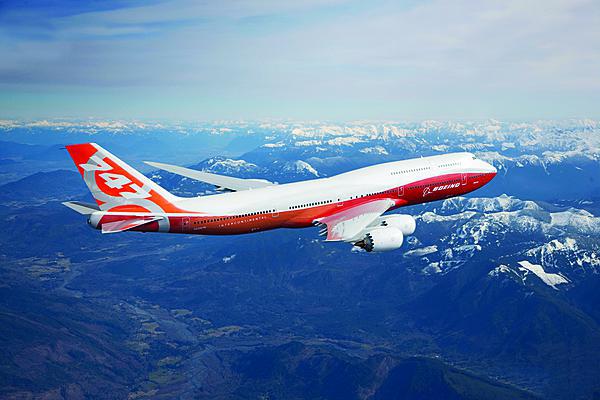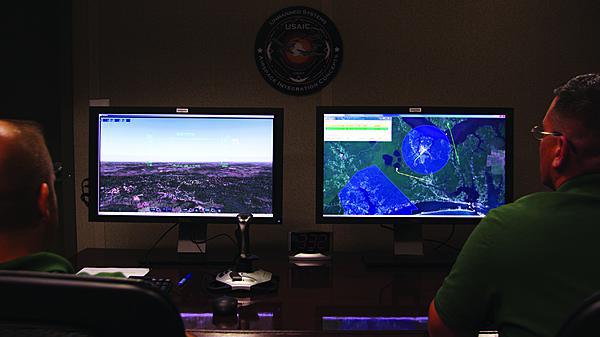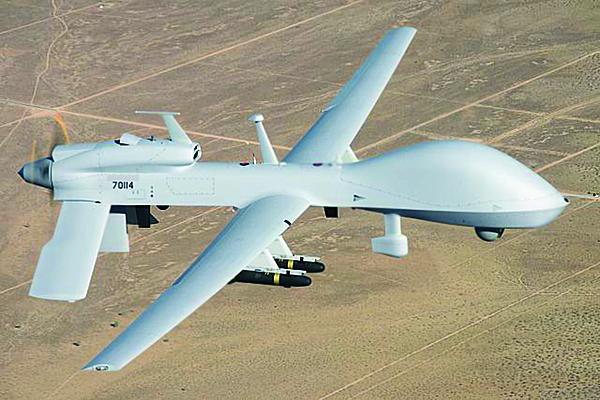Mixing With Manned Aircraft
A new crash avoidance system will allow both manned and unmanned planes to operate in U.S. airspace.
The U.S. Army is developing a collision avoidance system that will allow unmanned and manned aircraft to fly in the same airspace more easily and safely. The first-of-its kind system will enable service operators returning from the war zone to fly drones in the same U.S. skies as civilian aircraft, keeping the warfighters proficient and ready for the next conflict.
The Federal Aviation Administration (FAA) requires that a pilot be able to see and avoid other aircraft flying in the same airspace. But of course, drones have no onboard pilots. The Army currently has two FAA-approved options for meeting the requirement, and neither option is good, service officials say. The first is to fly a manned chase aircraft, such as a Cessna or a helicopter, behind the unmanned air system (UAS) to ensure it complies with FAA safety regulations. “It’s expensive. You can’t chase at night, and you can’t chase in clouds, so warfighters are limited,” says Viva Austin, Army product director for the Unmanned Systems Airspace Integration Concepts office. Another option is to use ground observers, but the observer must remain within about a mile and a half of the aircraft.
But with the Ground Based Sense and Avoid (GBSAA) system, the Army will be free to fly unmanned systems, such as the MQ-1C Gray Eagle, in the same airspace being used by military or commercial aircraft such as Boeing 747s. The GBSAA currently uses 3-D radar to track air traffic, but other sensors are possible. It will classify whether a target object is a bird potentially to be ignored or an aircraft to be avoided. The system will track aircraft altitude, speed and heading and will notify the user whether aircraft are ascending or descending. It also will tell the operator whether another aircraft is “cooperative.” Aircraft are deemed cooperative if they are transmitting identifying transponder information or if the crew is communicating with air traffic control via radio. Non-cooperative, or non-communicating, aircraft may be more of a collision threat. “Guys who are squawking and in contact with air traffic control, you can do something about. The non-cooperative traffic is really a big challenge. The display will distinguish between those two,” explains Larry Herbek, an SAIC contractor and senior engineer for the GBSAA program.
The system currently is funded for fielding at five locations where Gray Eagles are based and where operators train: Fort Hood, Texas; Fort Riley, Kansas; Fort Stewart, Georgia; Fort Campbell, Kentucky; and Fort Bragg, North Carolina. The first system is expected to be fielded in March 2014 at Fort Hood. About three months later, it is slated for fielding to Fort Riley. All five sites should be equipped with the GBSAA system by spring 2015. The sites and order of fielding were chosen based on the greatest need, according to officials. About the time the last system is fielded, the Army will begin upgrading the systems installed earlier. “We’ll go from block zero to block one almost immediately, right about the time we finish installing the fifth unit equipped,” Austin says.
The GBSAA algorithms are based on upgrades the FAA is implementing to its own collision avoidance system, which is important because the FAA ultimately will have to certify the GBSAA. “It’s just a mutation of their system. Instead of manned aircraft, it’s modified for unmanned aircraft,” Austin states. But modifying the software for unmanned aircraft is no easy feat, especially because the system is being designed to work with every kind of unmanned system. “The maneuver algorithms are specifically designed to allow for personality modules, where one aircraft may be able to turn faster or maneuver better than another, so the slower one you’d have to maneuver earlier. The algorithms are designed to take all of that into consideration,” Herbek reports.
Austin adds that the radar currently being used is based on a proven Army lightweight counter-mortar radar. The Army is working with not-for-profit organizations to develop the system. They include Johns Hopkins University, Baltimore; MIT Lincoln Laboratory, Lexington, Massachusetts; and SRC Incorporated, Syracuse, New York.
The GBSAA system recently underwent a two-week demonstration at Dugway Proving Ground, Utah, where the Army put it through multiple training vignettes that validated the system’s design and functionality. The first three vignettes used real unmanned aircraft. During the first two, Skywarrior and Hunter drones flew against synthetic, or virtual, intruders in its airspace, but the service used a different version of the GBSAA for each. In both scenarios, the system performed without endangering the mission, but on the second run, the Army Phase 2 Block 0 system’s improved algorithms indicated an earlier, safer departure time between intrusions. Vignette 3 pitted two Shadow unmanned aircraft against each other. One of the Shadows served as the intruder aircraft; the other was guided by the GBSAA. The operator of the GBSAA-guided aircraft was warned at an appropriate time and was able to follow the recommended maneuver to avoid the intruder.
The next three vignettes showed the adaptability of the Phase 2 Block 0 algorithms, according to Army officials. They were flown using a synthetic, or virtual, UAS through the X-Plane system, a commercial off-the-shelf flight simulator for a personal computer. “Kids play it at home on their PCs, but it’s very, very capable with some pretty sophisticated interfaces,” Herbek says. “It has been adapted and pretty tightly coupled into our testbed to act as an unmanned aircraft.” Each of the second three vignettes replicated airspace over different military installations, including Marine Corps Air Station, Cherry Point, North Carolina; Fort Stewart, Georgia; and Fort Drum, New York. In the final scenario, the GBSAA system was demonstrated again using a synthetic UAS, but it was flown using live aviation traffic data around nearby Salt Lake City and also against recorded air traffic data from Boston’s Logan Airport. “You’re flying everything like it’s real, and you put yourself in real traffic. You drop yourself down in there and try to react to actual, live traffic,” Austin explains.
The GBSAA is designed to “self separate,” Austin says, which means it is designed to keep the unmanned system far, far away from other aircraft. The feature worked so well during the demonstration that operators had a hard time maneuvering the unmanned plane into a crisis situation. “It is usually pretty far out that the algorithms will tell you there’s an encounter coming up and you need to do this or that. You put yourself in Salt Lake City where air traffic is very tightly controlled, and you try to get yourself in a situation where the red alert’s going off and your collision avoidance system is telling you to do something, but it’s hard to put yourself in that situation. You kinda end up chasing people down,” she reveals.
Because the GBSAA is not a mobile system, it does have limitations, especially for larger unmanned systems, such as Global Hawk, which fly longer distances. “You can’t take GBSAA with you,” Austin offers. The point is driven home by Dyke Weatherington, director, Unmanned Warfare and Intelligence, Surveillance and Reconnaissance, Strategic and Tactical Systems in the Office of the Undersecretary of Defense for Acquisition, Technology and Logistics and the Office of the Assistant Secretary of Defense for Acquisition. Weatherington says that for longer-range aircraft, “An organic, onboard system is required. The Air Force and the Navy have the lead and are jointly working on that capability. That is probably three or four years beyond the ground-based system. It is a little more challenging, but both are working well.”
The Army has a more immediate need than the other services for a collision avoidance system, and its smaller aircraft will not be able to handle the size, weight and power requirements of the airborne technology. “What we’ve found is that ground-based is more of a near- to mid-term solution. Airborne is more of a far-term solution, and really the ultimate solution is a combination of the two. You want them to work together,” Austin says. With that in mind, she and her team regularly meet with representatives from the other services. “The Air Force has been working on updating the software on air traffic control radar that the FAA had. We’re talking with their representatives about what they could use of our system. Navy officials have pretty much said they are focusing on [Broad Area Maritime Surveillance], and when the Army comes out with a solution, they will probably just buy the Army system,” Austin reports.
Army officials are open about remaining technical challenges. “We have to make sure that no matter what happens, it identifies all of the aircraft. And if it errs, it errs on the side of a bird being identified as an aircraft rather than the other way around where the operator potentially ignores a plane. There’s a fair amount of work to be done there,” Herbek says.
Additionally, during the recent demonstration, the GBSAA sometimes suggested some nontraditional avoidance maneuvers that could work well for unmanned systems but also could put traffic controllers or pilots on edge. “The other challenge involves the intricacies of how we want the algorithms to work and how we want our unmanned aircraft to behave in the airspace, so that they behave the way air traffic controllers expect them to. That algorithm behavior is probably the last remaining big challenge,” Herbek states.
Besides the demonstration, the GBSAA team members say they have had other recent successes, including gaining agreement from the other services on the first set of common requirements. “They’re small wins, but they add up to big wins,” Austin concludes.







Comments